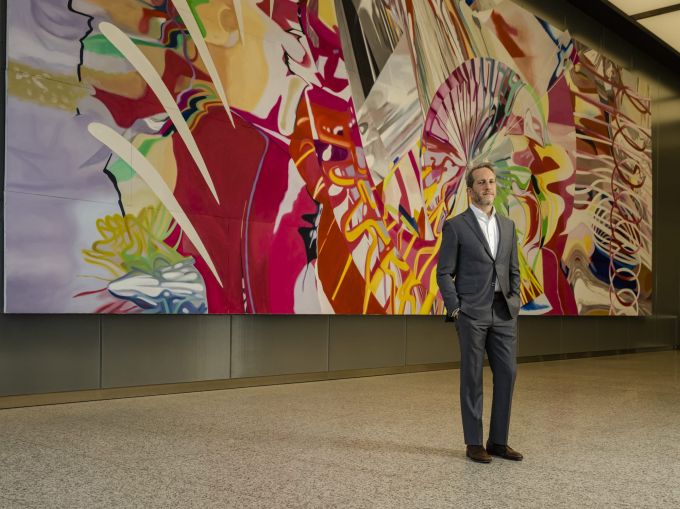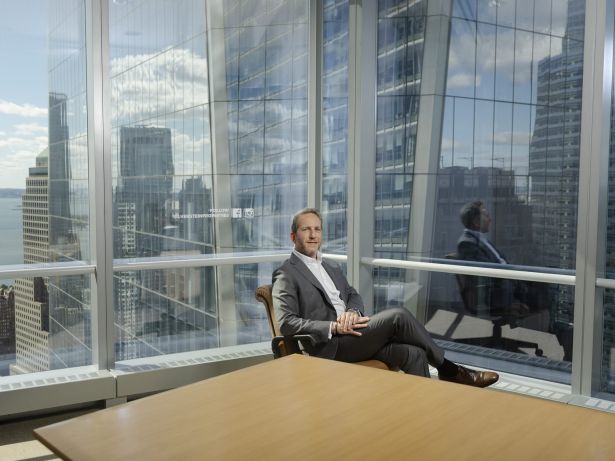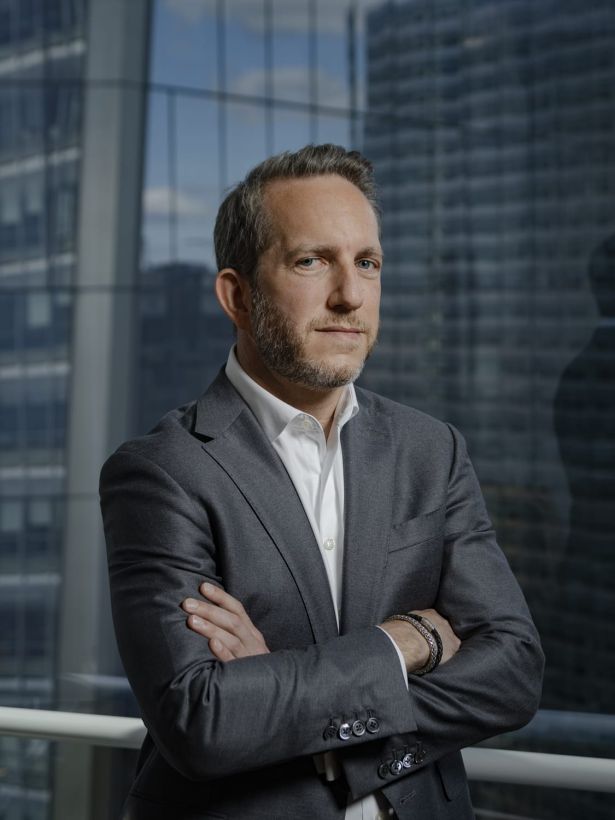Silverstein’s Jeremy Moss on Tenants’ Needs During COVID-19 and Return to the Office
By Nicholas Rizzi October 13, 2020 11:53 am
reprints
Don’t tell Silverstein Properties’ Jeremy Moss that New York City is dead.
The Upper West Side native and current West Village resident has heard the spiel about the death of New York many times throughout his life. And he doesn’t believe for a second the coronavirus pandemic will be the final nail in the coffin others have pontificated it would be.
“I almost start laughing when I hear that,” said Moss, executive vice president and director of leasing for Silverstein Properties. “Even in my short 45 years of existence, I heard that three times, and it just never happens … New York City always finds a way to come back. There are certain fundamentals here that make it perfectly suited to adapt over time to changes in the world.”
And Moss’ office inside 7 World Trade Center is a testament to the city’s resiliency. The original 7 World Trade tower — built in 1987 — collapsed on Sept. 11. In 2006, Silverstein opened a new 52-story building in its wake, signaling the start of the rebirth of Lower Manhattan after the terrorist attacks.

Since then, Silverstein has overseen the $30 billion rebuilding of the 9.5 million-square-foot office complex, with the exception of the Durst Organization’s 1 World Trade Center. Last year, Moss led a flurry of leasing activity at the site.
Deals included Uber taking a massive 307,390 square feet at 3 World Trade Center, along with spirits giant Diageo’s 87,000-square-foot and mattress firm Casper’s 70,000-square-foot deals in the same building. Silverstein also leased 82,000 square feet to liquor conglomerate Moët Hennessy, which Moss said was particularly exciting because it was part of “the second generation of tenants moving into the World Trade Center.”
And, while activity has nearly screeched to a halt during the pandemic, Silverstein was able to sign two deals in recent months within its downtown portfolio: Old Mission Capital expanding to 11,173 square feet at 120 Broadway and Nathan Cummings Foundation taking 13,751 square feet at 120 Wall Street.
Commercial Observer sat down (in person for the first time in months) with Moss to talk about tenants’ needs during the pandemic, how Silverstein is helping companies return to the office, and Lower Manhattan’s outlook post-COVID-19 shutdown.
Commercial Observer: Last year, there was a lot of leasing activity at the World Trade Center. How did that come together?
Jeremy Moss: I think all of the attributes of Lower Manhattan had finally penetrated the consciousness of everyone in the real estate community and the business community. When we hit that point, we found ourselves sort of oversubscribed for space and seeing interest from every conceivable industry.
Was that an important part of your leasing plan to get tenants from a variety of different sectors?
I think it was a reflection of what downtown has become. This place works for so many different kinds of companies for one simple reason: these companies all share a desire to attract the best talent in the city, and they all believe that this location will let them do that. You have a diversity of industries here that makes it a really exciting place to be. And that’s not just a World Trade Center trend; that’s a Lower Manhattan trend.
Ultimately, and this is another really important aspect of New York City’s success, we have a diversity of office product here. It’s not a one-size-fits-all, and that allows us to have small companies that are just emerging, and allows us to have huge corporations.
How has leasing activity been during COVID-19, and how have you navigated this time?
Leasing is obviously way down. It’s very hard for people to lease space when they can’t tour space, and there was a period — four or five months — where people really couldn’t tour space. We were all being responsible New Yorkers, and we were quarantining and following the direction of our policymakers, which has put us in a much better place today in terms of the pandemic. But, the result of not being able to tour is people weren’t able to proceed with their plans. There’s no question things are picking up. We’ve had a lot of tours, we’re now trading proposals with tenants, and we even managed to sign two leases during the pandemic.
We closed on the purchase of a 1.4 million-square-foot building in Los Angeles, the U.S. Bank Tower. We refinanced 120 Wall Street and we’re about to refinance 529 Fifth Avenue [which closed on Oct. 9]. We hired and onboarded at least two people, we submitted a proposal for a major development site in Manhattan, and all of the tenants that we’ve had building out space have resumed their construction.

Before this, downtown was seeing a lot of activity and companies were relocating. Do you think the coronavirus pandemic could have any potential to derail that?
No, not unless you’re telling me everybody’s going to leave Brooklyn and all the neighborhoods that are surrounding us, which have always been the most popular neighborhoods to live in New York City. When people are like, “Where would you love to live in New York City?” You hear Tribeca, you hear Battery Park, you hear all the neighborhoods in Brooklyn, Lower East Side, SoHo, the West Village. Those are amazing neighborhoods. That’s one of the reasons people want to work in Lower Manhattan, because it’s close to where they live. If you survey all of our tenants, you find a lot of them are close enough that they can walk because we’re just surrounded by residential communities. That’s also what makes us feel like a 24-7 neighborhood as opposed to the more 9-to-5 feel of Midtown.
The transportation, the great restaurants, and all of the things that made Lower Manhattan’s resurgence possible haven’t disappeared. I think all neighborhoods are feeling the effects of the pandemic equally.
Labor Day was seen as a big marker for companies returning to the office. Have you seen tenants return to your properties?
Little by little. I don’t think it’s a light switch. I think it’s more, we’re slowly increasing the lighting level, so it’s going to be a slow ramp-up. But I think a lot of it is people sharing anecdotes. So, if we could share our anecdote, I think that would give people a lot of comfort. I think it’s just the absence of understanding how safe the office is.
We follow very strict protocols here, and that’s why our leadership was comfortable returning to work. We also knew that, to achieve all the things we wanted to achieve and to remain competitive, we needed to be together. So, we made an effort to think about, how do we do that? How do we achieve our business goals without compromising the safety of our employees? All the protocols that we’ve put in place do exactly that. From wearing masks when we’re in offices together, using conference rooms with very sparse seating, daily check-ins to see how people are feeling to rotating the company through so we never have more than roughly a third of our workforce here at any given time. We also benefit, particularly at the World Trade Center, from hospital-grade air filters.
We practice what we preach — surprise, surprise — and we’re the beneficiaries of the work that we’ve done. Our hope is that other people will follow suit. Because everyone is saying — and, when I say everyone, I mean everyone — there is no question that we do better when we’re in the office. At this point, I can pull up a list of a million articles in which CEOs are like, “We got to get back to work, we need to be in the office. This is affecting our productivity. It’s affecting our creativity. It’s affecting people’s mental health.” There are all these compelling reasons to return and, I think if more people start to follow the protocols, or commit to following the protocols, they can slowly bring people back to work in a safe way.
How have you been working with clients on the return to the office?
Each building we did a town hall Zoom meeting in which we invited the representatives of every commercial office tenant to participate and learn what we did to make the building safe and healthy, and then what they could, in turn, do with their space. We share with them all of the practices we follow within our own office space here at 7 World Trade Center, and many of them were grateful for the information. I think it’s incumbent upon company leadership to set the tone. From the very first day we decided to return to work, our CEO [Marty Burger] was here. That was really important.
With prospective tenants starting to resume tours, has the pitch changed for you or is it similar to before the pandemic?
It’s pretty similar. I think the difference is people are taking a little more time to think about whether they need to change the way they design and use their space, on the margins. The notion that we’re completely going to do away with office space or it’s going to look totally different, I think, is a fallacy.
Maybe we have a little more collaborative space and a little less focus space, because we understand that we come together to be together. So, that could influence design on the margins. Overall, people are planning for the future; they know they need to have great space to attract great talent to be competitive. They also know that there is no future without office space. There’s no future without human beings being able to come together to work together for a common goal.
Do you think tenants have started to shift away from the open floor plan model in the wake of this?
I don’t think the ultra-high densities that people once used will necessarily return, but I still think there will be a reasonable level of open space and density. I don’t think it makes sense to plan your entire future around an event that has a beginning and an end, an event that is temporary. That would mean, like, permanently affixing sunglasses to your face, even though, at night, the sun goes down. Again, I think things are going to change on the margins.
Has this pandemic driven tenants more toward new construction?
To a degree, yes. I think there’s a level of air filtration, there’s a level of spaciousness here that makes people feel more comfortable.
But I also think it’s who owns the building. Those owners who have gone to the extra lengths, much of which is not required by law. We’ve done it because it’s the right thing to do. It’s about taking care of your customers, and looking out for their safety and their well-being, the same way the leadership of those companies looks out for their employees. We tried to put ourselves in the position of the leadership of the companies that occupy these buildings, and take care of their employees as though they were our own employees. That’s the philosophy that drives a lot of what we do.
When you walk into 7 World Trade Center, it is apparent that the safety of the occupants is the first, second and third thought on the mind of the owner of this building. I don’t know that every building in New York City has gone to the lengths that we have gone. I think a lot of the great landlords have, there’s no question; but there are other buildings where it’s more challenging for a number of reasons.
You mentioned that New York City has been through plenty before. Has working through the rebuilding process of this area sort of taught you lessons to get through this time?
No question. I think you have to understand that, a big part of this, just as with 9/11 and just as with the financial crisis, is emotional. You have to have a great deal of respect for people’s emotional reactions to very difficult times. You have to have a good ear. You have to be willing to listen and be people’s partner in finding a way back and recovering from whatever the challenge is. As long as that dialogue exists between, not just landlords and tenants, but any customer and service provider, or any two people, you’re going to have a much better outcome. You’re going to get there a lot quicker.


